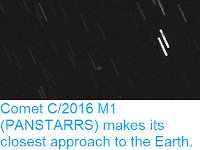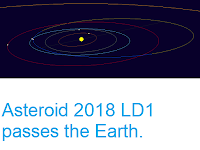Asteroid 2018 MG7 passed by the Earth at a distance of about 3 605 000
km (9.40 times the average distance between the Earth and the Moon, or 2.41% of the distance between the Earth and the Sun), slightly before 9.25 pm
GMT on Saturday 23 June 2018. There was no danger of
the asteroid hitting us, though were it to do so it would have
presented a significant threat. 2018 MG7 has an estimated
equivalent
diameter of 110-340 m (i.e. it is estimated that a spherical object
with
the same volume would be 110-340 m in diameter), and an object of this
size would be predicted to be capable of
passing through the Earth's
atmosphere relatively intact, impacting the ground directly with an
explosion that would be 600 to 88 000 times as powerful as the
Hiroshima
bomb. Such an impact would result in an impact crater 1.5-5 km
in
diameter
and devastation on a global scale, as well as climatic effects that
would last years or even decades.
The calculated orbit of 2018 MG7. Minor Planet Center.
2018 MG7 was discovered on 20 June 2018 (three days before its closest approach to the Earth) by the Southern Observatory for Near Earth Asteroids Research (SONEAR) at Oliviera in Minas Gerais State, Brazil. The
designation 2018 MG7 implies that it was the 182nd asteroid (asteroid G7)
discovered in the second half of June 2018 (period 2018 M).
2018 MG7 has a 318 day orbital period, with an elliptical orbit tilted at
an angle of 25.1° to the plain of the Solar System which takes in to
0.61 AU from the Sun (61% of the distance at which the Earth orbits the
Sun and considerably inside the orbit of the planet Venus) and out to
1.21 AU (21%
further away from the Sun than the Earth). This means that close
encounters between the asteroid and Earth are fairly common, with the
last thought to have happened in November 2017 and the next predicted
in January 2024. 2018 MG7 also has frequent close encounters with the
planet Venus, with the last thought to have occurred in December 2010
and
the next predicted for May 2021. Although it does cross the Earth's
orbit and is briefly
further from the Sun on each cycle, 2018 MG7 spends most of its time
closer to the Sun than we are, and is therefore classified as an Aten
Group Asteroid. As
an asteroid possibly larger than 150 m in diameter that occasionally
comes within 0.05 AU of the Earth, 2018 MG7 is also classified
as a Potentially Hazardous Asteroid.
See also...
Follow Sciency Thoughts on Facebook.







